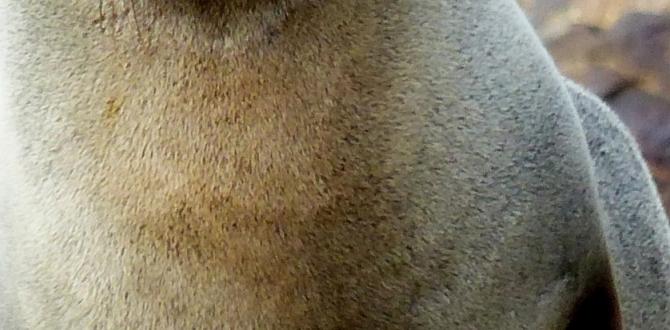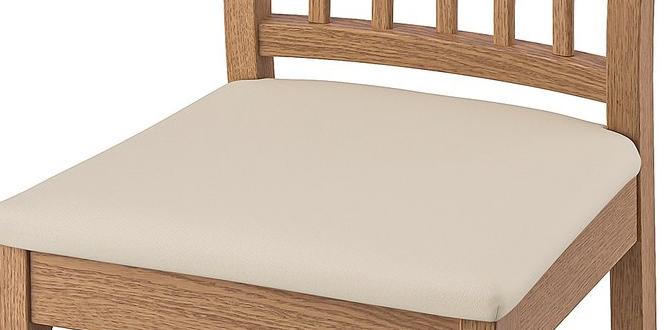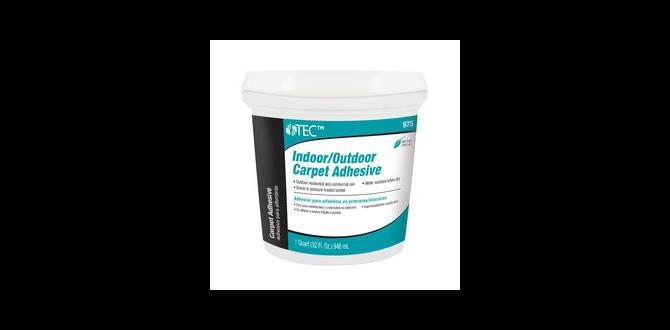Have you ever wondered why some outdoor wood items look old and worn out? It’s sad to see a beautiful bench or swing fade away. The good news is, you can prevent that! Learning how to seal wood for outdoors is a fun and rewarding project. With just a few simple steps, you can keep your wood looking fresh and new for years.
Imagine your backyard filled with vibrant wooden furniture that you can enjoy every day. Wouldn’t that be amazing? Sealing wood protects it from rain, sun, and bugs. It acts like a shield, making sure your outdoor wood stays strong.
Did you know that untreated wood can absorb water like a sponge? This can lead to cracks and mold. But don’t worry! In this article, we will share easy methods to seal wood so you can have a beautiful outdoor space.
How To Seal Wood For Outdoors: A Complete Guide

How to Seal Wood for Outdoors
Sealing wood for outdoor use protects it from weather damage. Choosing the right sealant is key. A quality sealant shields against moisture and UV rays. Have you ever noticed how untreated wood quickly gets damaged? Just think about that old swing set! To seal wood, first clean the surface, then apply the sealant evenly. Finally, allow it to dry completely. This simple process can extend the life of your wood products significantly. Don’t let your wood fade away!Understanding the Importance of Sealing Wood
Protects wood from moisture and decay. Increases durability and lifespan of outdoor furniture.Sealing wood is like giving your outdoor furniture a cozy raincoat. It protects against moisture and keeps decay away, ensuring your wooden wonders stay strong. Think of it as a superhero cape, boosting the durability and lifespan of your favorite chairs or tables. Without sealing, wood can rot faster than a sandwich left out on a sunny day! So, to keep your outdoor pieces looking fresh and fabulous, sealing is key.
| Benefit | Effect |
|---|---|
| Moisture Protection | Prevents rot and decay. |
| Increased Lifespan | Makes wooden furniture last longer. |
Choosing the Right Sealant for Outdoor Wood
Types of sealants: oilbased, waterbased, and hybrid. Factors to consider: wood type, climate, and intended use.Finding the right sealant for outdoor wood is like choosing the perfect ice cream flavor—it can get tricky! There are three main types of sealants: oil-based, water-based, and hybrid. Oil-based sealants are great for deep protection but can be a bit smelly. Water-based options dry quickly and are easy to clean up. Hybrid sealants mix the best of both worlds!
When picking your sealant, think about the type of wood, the climate, and what you plan to use it for. For example, softwoods need different care than hardwoods. Keep in mind that sunny spots and rainy days can change your sealant’s performance. Just like a superhero, your sealant must be ready for anything!
| Sealant Type | Best For | Pros | Cons |
|---|---|---|---|
| Oil-based | Heavy-duty protection | Long-lasting, deep penetration | Strong odor, longer drying time |
| Water-based | Easy clean-up | Fast drying, low odor | May not last as long |
| Hybrid | Versatile uses | Best of both oil and water | Can be more expensive |
Preparing the Wood Surface for Sealing
Cleaning the wood: removing dirt, dust, and old finishes. Sanding: achieving a smooth surface for better adhesion.Before sealing wood for outdoor use, it’s important to prepare the surface. Start by cleaning the wood. This means removing dirt, dust, and any old finishes. Think of it like giving the wood a shower—nobody wants to seal a dirty surface! Next, grab some sandpaper and sanding will make a world of difference. A smooth surface helps the sealant stick better. Imagine trying to stick a band-aid on a fuzzy peach; it just won’t work! Here’s a quick guide:
| Step | Action |
|---|---|
| 1 | Clean the wood |
| 2 | Sand the surface |
Step-by-Step Guide to Sealing Wood for Outdoors
Applying sealant: tools and techniques. Recommended application methods: brush, roller, or spray.Sealing wood for outdoor use can be fun and rewarding! First, gather your tools: you’ll need a brush, roller, or spray bottle. A brush works well for detail, while a roller covers larger areas quickly. If you’re feeling fancy, try spray—just don’t spray your neighbor’s pet! Apply the sealant evenly to avoid streaks. Make sure to do this in a shady spot to let it dry nicely. Happy sealing!
| Application Method | Best For |
|---|---|
| Brush | Detailed work |
| Roller | Large surfaces |
| Spray | Quick application |
Best Practices for Sealing Wood
Tips for achieving even coverage. Avoiding common mistakes during application.Covering wood evenly is like spreading peanut butter on bread—easy if you know how! Use a high-quality brush or foam applicator to ensure smooth strokes. Start from one end and work your way to the other to avoid missed spots. Be careful not to over-saturate the brush, as this can lead to drips and runs. Remember, too much product is a “no-no”! Also, let each coat dry completely before adding the next one. It keeps things looking sharp.
| Common Mistakes | How to Avoid Them |
|---|---|
| Skipping sandpaper | Always sand the wood first for better adhesion. |
| Applying in direct sunlight | Choose a cool, shaded day for application. |
| Not cleaning the surface | Wipe off dust and dirt before sealing. |
With these tips, your wood will look fabulous and last longer. Happy sealing! Remember, nobody wants a drippy mess—unless you’re talking about ice cream. Then it’s totally fine!
Maintenance Tips for Sealed Outdoor Wood
Regular inspections to identify wear or damage. Recommendations for resealing and upkeep.Keeping your sealed outdoor wood in great shape is important. Regular inspections help find any wear or damage early. Check your wood at least twice a year. Look for cracks, peeling, or fading. If you spot these, it’s time to act. Resealing helps protect the surface. Use a good wood sealant every 1-3 years. Clean the wood before resealing it. This keeps it strong and beautiful!
How often should I inspect my outdoor wood?
You should inspect your outdoor wood twice a year. This helps catch damage before it gets worse.
Tips for Resealing and Upkeep:
- Clean the wood surface first.
- Apply sealant evenly.
- Use a brush or roller for best results.
- Allow proper drying time.
DIY vs. Professional Sealant Application
Pros and cons of sealing wood yourself. When to consider hiring a professional.Sealing wood can be fun and cost-effective. But how do DIY methods compare to hiring a pro? Here are some important points:
- Pros of DIY: Save money, learn a new skill, and control the process.
- Cons of DIY: Risk of mistakes, longer time, and harder to get a perfect finish.
- When to hire a pro: Large projects, tricky wood types, or if you’re short on time.
Many people enjoy the challenge of sealing wood. However, professionals can ensure a smooth result, especially for tricky jobs.
Should I seal wood myself or hire someone?
It depends on your skills and the project size. Small jobs are great for DIY, but bigger ones may need experts.
Frequently Asked Questions about Sealing Wood
Common inquiries and expert answers. Troubleshooting issues with sealing.Got questions about sealing wood? You’re not alone! Many folks wonder if they should apply the sealant before or after sanding. The answer? Always sand first! This makes the wood smooth and ready for a good seal. Another common query is about drying times. Remember, patience is key! Always let the sealant dry fully before taking your masterpiece outdoors. To help you further, here’s a handy table with top FAQs:
| Question | Answer |
|---|---|
| Can I seal wet wood? | No, dry wood is best for sealing! |
| How long does sealing take? | Typically 24 hours, but check the product! |
| Is one coat enough? | Two coats are often better! |
With some care and these tips, your outdoor wood projects will be safe from the elements. Who knew sealing could be so simple and entertaining?
Additional Resources for Wood Sealing
Recommended tools and products. Links to instructional videos and articles.Using the right tools and products can make sealing wood easier. Essential tools include a paintbrush or roller, sandpaper, and a clean cloth. You may also want to use a sprayer for large areas. For sealers, look for water-resistant and UV-protective options. Check these resources:
- Youtube: Search for “how to seal wood for outdoors” for helpful videos.
- Websites: Many DIY websites offer step-by-step articles.
These materials can guide you. They help you understand which products work best.
Conclusion
In conclusion, sealing wood for outdoors helps protect it from weather damage. Choose a good sealant and apply it properly. Clean the wood first and follow all instructions. Reapply the sealant every few years for best results. Now that you know how to seal wood, gather your materials and get started. For more tips, keep reading!FAQs
What Types Of Sealants Are Best For Outdoor Wood Surfaces?The best sealants for outdoor wood are water-based or oil-based types. Water-based sealants are easy to clean and dry fast. Oil-based sealants last longer and protect against water better. You can choose which one fits your project, but both will help keep the wood safe. Always follow the instructions on the label!
How Do I Prepare Wood Before Applying A Sealant For Outdoor Use?To prepare wood for sealant, first, clean it. You can use a brush or cloth to remove dust and dirt. Next, sand the surface lightly to make it smooth. This helps the sealant stick better. Finally, let the wood dry completely before applying the sealant.
What Is The Recommended Application Process For Sealing Wood Outdoors?To seal wood outdoors, first clean the wood. You can use soap and water or a wood cleaner. Let it dry completely before sealing. Next, choose a wood sealant and read the instructions. Then, use a brush or roller to apply the sealant evenly. Make sure to cover all sides. Finally, let the sealant dry according to the instructions before using the wood.
How Often Should Outdoor Wood Be Re-Sealed To Maintain Its Durability?You should re-seal outdoor wood every one to three years. It depends on the weather and how much sun and rain it gets. If the wood looks faded or dull, it’s time to re-seal it. This helps keep the wood strong and looking nice!
Are There Specific Environmental Conditions To Consider When Sealing Wood For Outdoor Use?Yes, there are important things to think about when sealing wood for outside use. You should do it on a dry day. If it rains, the seal won’t stick well. Also, avoid sealing wood when it’s too hot or too cold. Make sure the wood is clean and dry for the best results.







